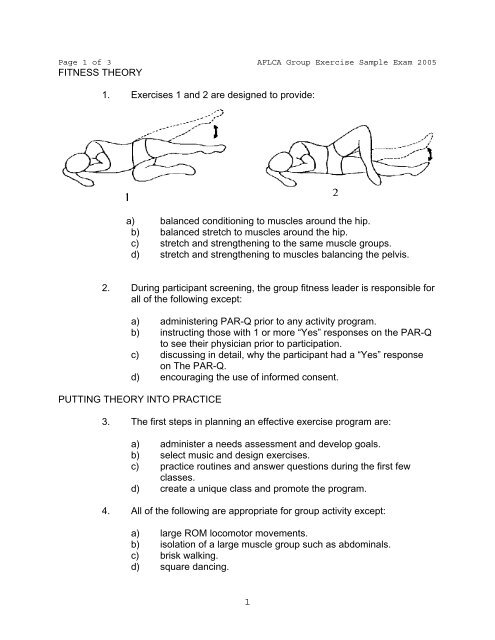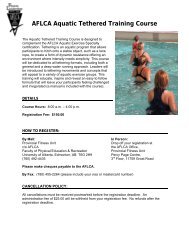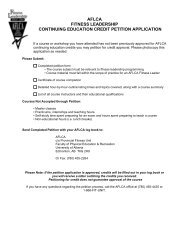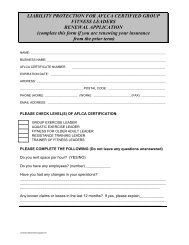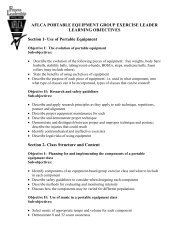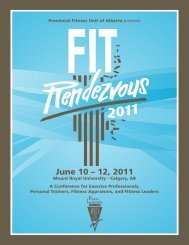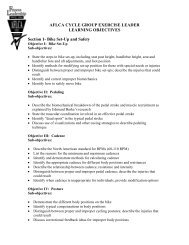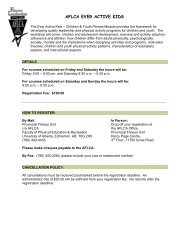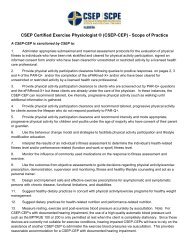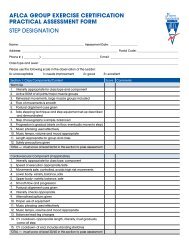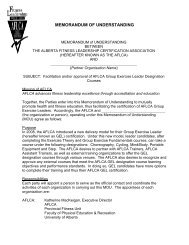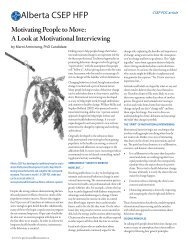Group Exercise Sample Questions - Provincial Fitness Unit
Group Exercise Sample Questions - Provincial Fitness Unit
Group Exercise Sample Questions - Provincial Fitness Unit
Create successful ePaper yourself
Turn your PDF publications into a flip-book with our unique Google optimized e-Paper software.
Page 1 of 3 AFLCA <strong>Group</strong> <strong>Exercise</strong> <strong>Sample</strong> Exam 2005<br />
FITNESS THEORY<br />
1. <strong>Exercise</strong>s 1 and 2 are designed to provide:<br />
a) balanced conditioning to muscles around the hip.<br />
b) balanced stretch to muscles around the hip.<br />
c) stretch and strengthening to the same muscle groups.<br />
d) stretch and strengthening to muscles balancing the pelvis.<br />
2. During participant screening, the group fitness leader is responsible for<br />
all of the following except:<br />
a) administering PAR-Q prior to any activity program.<br />
b) instructing those with 1 or more “Yes” responses on the PAR-Q<br />
to see their physician prior to participation.<br />
c) discussing in detail, why the participant had a “Yes” response<br />
on The PAR-Q.<br />
d) encouraging the use of informed consent.<br />
PUTTING THEORY INTO PRACTICE<br />
3. The first steps in planning an effective exercise program are:<br />
a) administer a needs assessment and develop goals.<br />
b) select music and design exercises.<br />
c) practice routines and answer questions during the first few<br />
classes.<br />
d) create a unique class and promote the program.<br />
4. All of the following are appropriate for group activity except:<br />
a) large ROM locomotor movements.<br />
b) isolation of a large muscle group such as abdominals.<br />
c) brisk walking.<br />
d) square dancing.<br />
1
Page 2 of 3 AFLCA <strong>Group</strong> <strong>Exercise</strong> <strong>Sample</strong> Exam 2005<br />
5. Exercising to music has numerous benefits. However, music does not:<br />
a) control the pace of various parts of the class.<br />
b) change physiological responses to exercise.<br />
c) set or change a particular mood.<br />
d) encourage more dramatic movement.<br />
6. The most suitable musical tempo for stretching is:<br />
a) 135 - 160 beats per minutes.<br />
b) 124 - 150 beats per minute.<br />
c) 90 - 135 beats per minute.<br />
d) 50 - 106 beats per minute.<br />
7. In an exercise class, music should:<br />
a) have a strong base beat.<br />
b) be selected for its tempo and mood.<br />
c) never go over 160 b.p.m..<br />
d) be a 4/4 rhythm.<br />
8. To accommodate the beat for fast paced music, use:<br />
a) only lower body movements.<br />
b) shorter levers.<br />
c) well known exercises.<br />
d) a large range of motion.<br />
9. A positive climate can be established if participants are encouraged to:<br />
a) express their opinions.<br />
b) rely on the leader as the expert role model.<br />
c) have a good workout.<br />
d) recall exercises from previous sessions.<br />
10. During this exercise, the verbal cue that may lead to participant<br />
discomfort or strain is:<br />
2
Page 3 of 3 AFLCA <strong>Group</strong> <strong>Exercise</strong> <strong>Sample</strong> Exam 2005<br />
a) “keep your eyes on me at all times”.<br />
b) “stretch out when the muscle feels fatigued”.<br />
c) “tuck the pelvis under”.<br />
d) “keep a neutral back”.<br />
11. To help build rapport with a participant from the outset, a leader should<br />
be:<br />
a) genuine, attentive, accepting and recognize individual<br />
differences.<br />
b) discrete, soft spoken, and keep the conversation confidential.<br />
c) genuine, give accurate advice, and effectively problem-solve.<br />
d) discrete, collect information, and give accurate advice.<br />
12. If a participant complains of a pain along the front of the leg, the<br />
leader’s first action should be to:<br />
a) explain that the condition is shin splints.<br />
b) ask for more information about the nature of the pain.<br />
c) direct the participant to their physician.<br />
d) design exercises for the lower leg.<br />
13. A characteristic of the active listening process is to:<br />
a) use non-verbal communication techniques while leading a class.<br />
b) demonstrate techniques to show proper exercise execution.<br />
c) use non-verbal messages with participants.<br />
d) use adult learning principles to problem solve.<br />
1.A 2.C 3.A 4.B 5.B 6.D 7.B 8.B 9.A 10.A 11.A 12.B 13.C<br />
3


